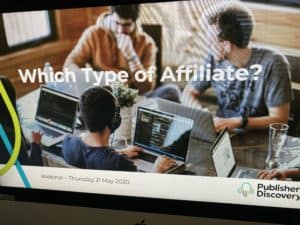This article is taken from the content of a Webinar on 21 May 2020, presented by Chris Tradgett.

Which Type of Affiliate is best for my Business?
We’ll start off with looking at ‘affiliate’ – and I want to tackle that old discussion: ‘Is affiliate marketing a channel?’
IS AFFILIATE MARKETING A ‘CHANNEL’?
This is a question that should be asked by all marketers, and is a particular bugbear of Geno Prussakov as he explains. He always argues that ‘affiliate’ should be seen as a payment model. If you are thinking ‘channels’, affiliate marketers operate in all actual channels. There are affiliates using PPC, email, content marketing, social media and all others.
By looking at affiliate as a channel, you miss the fact that they can actually be integrated into your activities across the channels – and not be seen as competing with them. For instance, working with affiliates to dominate your specific keywords in search (rather than preventing them from appearing) will help to drive your competitors down the listings.
SO, HOW MANY ‘TYPES’ ARE THERE?
There have been many attempts at categorising affiliates. Some are so concise – and others seem to be more of a laundry list! Some others we’ve seen have some very strange categories. The most important thing as an affiliate manager is to ensure you use the right approach to each. We’ll look at how to look at the differences in the publishers using the affiliate model and how that affects the way you recruit them.
BASIC TYPES
In the hundreds of attempts at classifying, there are some basic similarities across the different offerings – and we’ve tried to summarise them here. There are also a couple of examples to illustrate.
 REBATE – AFFILIATE COMMISSION PASSED ON
REBATE – AFFILIATE COMMISSION PASSED ON
The cashback or rebate sector is a mainstay of many programmes – and which comes in several guises, each with its own slant.
Pure cashback – membership websites which pay (some or all of) the affiliate commission to their member. These include sites like ebates and topcashback.
Loyalty – as with cashback, the commissions are used to provide members with benefits, usually in the form of point, such as Nectar.co.uk or AmericanExpress.
Charity fundraising – where commissions fuel fundraising efforts. There are plenty of these such as easyfundraising.co.uk and clevergiver.com
Some leading brands have taken the step to exclude any form of discounting, either by allowing affiliates to pass commissions on or via coupons/vouchers. The view is that this can damage the brand’s price/value differential.
COUPONS AND VOUCHERS
Coupons are the second main source of referrals and sales for many affiliate programmes.
Online coupons – there are thousands of sites which aggregate advertisers’ coupons, so you need to pick carefully. Examples include coupons.com,vouchercloud.com & mydealz.de.
Be aware though that many sites will include an advertiser on the site – and appear in Google search results. That can happen even if there are no active coupons available, so its always worth offering something as a ‘coupon’, even if it’s only your usual ‘free shipping over $XX spend’.
CONTENT PUBLISHERS
Here’s a huge range or publishers which really do range from the part-time blogger to multinationals. News Media, such as Hearst or Future Publishing, often with a large range of titles.
News media – The heavyweights in publishing such as wsj.com, Macuser.com or womansday.com. Many of these will use partners such as Skimlinks or Viglink – as well as direct links within their content.
Bloggers – enthusiast websites and often highly influential in their own niche. There is a lot of crossover with the next group, who largely grew from being bloggers, or via social media followings. There are literally thousands of these such as thefireboys.blogspot.com – themodestmomblog.com. Many do use affiliate so can be very useful to diversify your program – though you will need to recruit a lot to add significant referral volumes.
You can read more in our Publisher Spotlight series of articles. You can read more about Food Tours Japan, the Curvy Fashionista, Finder and Weather2Travel.
Influencers – the growth of ‘influencers’ in marketing has been well documented and the nuances of monetisation and engagement are still working out. It’s fair to say that there are almost as many types as there are are influencers. The big names from movies and sports, as well as those in social media command huge fees for activity.
There are literally thousands of mid range and long tail influencers across most verticals. With the influencer and affiliate models moving so much closer together, this is only going to be a growing sector.
Examples: thecurvyfashionista.com – myhostnews.com
Reviews – These publisher are the backbone of many verticals. Reviews are strong referrers in sectors such as software and webhosting, as well as most travel verticals. There are mainstream news media sites such as which.co.uk – reviewed.com. There are also plenty of others such top5hosting.co.uk and top10vpn.com.
SOFTWARE AND TECH SOLUTIONS
It can easily be argued that each of these is a category on its own.
Toolbars – These achieved an awful reputation in affiliate 10 years ago (such as 180 solutions) with sometimes drive-by instals which stole the last click across almost all programs. There are more honourable versions now appearing, such as Honey.com which are making this a more acceptable solution.
Remarketing and retargeting – has been a huge growth area in recent years. Leading proponents includeCriteo.com and Smarterclick.com which give huge benefits for online merchants in maximizing potential sales.
Shopping comparison –
Examples: shopping.com –
Secondary networks – There are a large variety of these, and with quite different. We have mentioned Skimlinks.com and Viglink.com. Similar technology is being used with coupon feeds specifically for influencers FMTC.co. The sector also includes many other more lead-gen focus ‘networks’ that drive sales via mainstream network tracking.
Datafeed – In certain sectors with large inventory, technically capable affiliates use datafeeds to populate their websites with template pages. Examples are in travel, tickets and many retails sectors. Many of those who started off as datafeed affiliates in past years have developed into meta-search partners, especially in travel for hotels and flights.
SEARCH BASED
PPC is a huge area. Many affiliates use PPC to drive traffic to their landing pages to arbitrage for affiliate commissions, though this takes a lot of skill ad knowledge to do successfully.
Domain oriented – publishers such as Barefruit.com who monetize mistype and ‘fatfinger’ typos with affiliate links to drive to merchants.
EMAIL AND LEAD MARKETING
The lead generation sector is responsible for significant generation of business. From Publisher Discovery point of view, its not a strength as our tech is not designed to track email marketing. We do see some landing pages used for ‘view in browser’.
Varying Recruiting Style
Publishers using the affiliate payment model vary in size from one-man part-time operators right up to major multinationals. The two extremes clearly need a very different approach when looking to recruit them.
You can see more in the session Styles in Affiliate Recruiting
Get Started Finding New Affiliates
If you want to put this in practice and look at diversifying your affiliate program, see how easy we have made the process.
Further Resources
Users’ article on contacting affiliates >
What is the Affiliate Management Role? >
35 Top Tips for Affiliate Management >
AM Navigator – 18 Types of Affiliate – Not a Channel
AM Navigator – 20 Affiliate Types and How They Can Grow or Harm Your Program
iAffiliate Management – 10 types of affiliate
Get blog updates to your inbox
By clicking Subscribe you are agreeing to receive email marketing communications from Publisher Discovery. We will not share your details with any 3rd parties and you can change your preferences at any time. Please review our Privacy Policy for more information.

